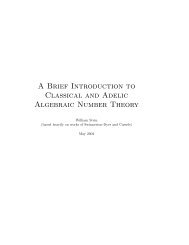Modular Elliptic Curves over Q(5) - William Stein
Modular Elliptic Curves over Q(5) - William Stein
Modular Elliptic Curves over Q(5) - William Stein
Create successful ePaper yourself
Turn your PDF publications into a flip-book with our unique Google optimized e-Paper software.
<strong>Curves</strong> <strong>over</strong><br />
Q( √ 5)<br />
W. <strong>Stein</strong><br />
Background<br />
The Plan<br />
Conductor<br />
What is the “Conductor” of an <strong>Elliptic</strong> Curve?<br />
If E, given by y 2 + a1xy + a3y = x 3 + a2x 2 + a4x + a6 is a<br />
Weierstrass equation for an elliptic curve <strong>over</strong> F , it has a<br />
discriminant, which is a polynomial in the ai:<br />
∆ = −a 4 1 a2a 2 3 + a5 1 a3a4 − a 6 1 a6 − 8a 2 1 a2 2 a2 3 + a3 1 a3 3 + 8a3 1 a2a3a4 + a 4 1 a2 4 − 12a4 1 a2a6 − 16a 3 2 a2 3 +<br />
36a1a2a 3 3 + 16a1a 2 2 a3a4 − 30a 2 1 a2 3 a4 + 8a 2 1 a2a 2 4 − 48a2 1 a2 2 a6 + 36a 3 1 a3a6 − 27a 4 3 + 72a2a 2 3 a4 + 16a 2 2 a2 4 −<br />
96a1a3a 2 4 − 64a3 2 a6 + 144a1a2a3a6 + 72a 2 1 a4a6 − 64a 3 4 − 216a2 3 a6 + 288a2a4a6 − 432a 2 6<br />
Among all models for E, there are some that simultaneously minimize<br />
ordp(∆) for all primes p: the minimal discriminant.<br />
Reducing such a model modulo p will give either an elliptic curve, or<br />
a nodal cubic (e.g., y 2 = x 2 (x − 1)), or a cuspidal cubic (e.g.,<br />
y 2 = x 3 ). The conductor of E is the ideal<br />
n = <br />
p fp<br />
p|∆<br />
where fp = 1 if reduction is nodal, and fp ≥ 2 if cuspidal...
















